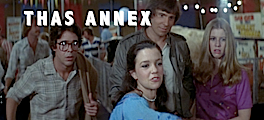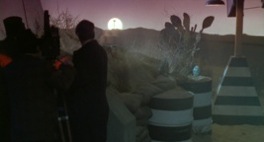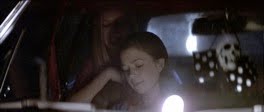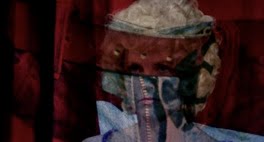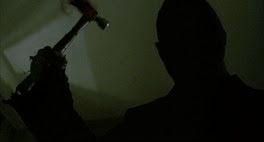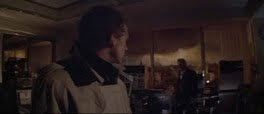Alternatively can be called "THAS: The Dispensation of Discreet Movement."


Cut-up still from "The Bag Lady/Restroom Scene" in The Funhouse (1981)
Nothing particularly brilliant or deep about this scene, outside of it being probably the film's most overt gesture toward the antiquated (in broad performance style and capricious flight of tone) and most explicit tonal gambit (one wonders what theatrical vocabulary of prelinguistic folk gesture or German Expressionist performance tradition the Bag Lady's conclusive "wink" is borrowed from), but rather, it is instead only ("only"*) highly emblematic of Hooper's entire notions of craft in film and cinematic idea.
* emphasis on the appended quotation of the word. Just as Eliot posed of Henry James's genius as that of a writer with "a Mind so Fine," without any "Ideas" ("He had a mind so fine that no idea could violate it"), here I betray my own position (pushing a notion of genius) through a backhanded compliment, which claims the artist's virtue is seen even clearer through a complementary lack. "Only" is the scene totally emblematic of Hooper's genius, without it being explicitly genius.
So while I have little to wax on about this scene, particularly thematically*...
* I find it a rather cut-and-dried bit of undiscerning levity, pushing merely the obvious vocalized irony. It falls 1 degree short of actually doing anything to attenuate the figure of the withered prude (as the film does excellently with the magician and the fortune teller)... if the stock character of "the Bag Lady" wasn't so clearly made comic, so inherently a grotesquerie the result of desiccant Victorian moral values (and Amy such an imperturbable, mindlessly and wonderfully anti-dogmatic unplucked flower) [side note: Amy and Genie from Night Terrors are the same character; Genie is an evolution, as she willfully schemes to escape bourgeoisie strictures], I'd almost be tempted to criticize the picture for pushing a God-fearing angle.
... While, as said, nothing of outstanding brilliance or profundity occurs in it, this one scene nevertheless serves as a condensed, simplified crystallization of one fundamental property of Hooper's sense of craft: his sense of a cinematic arithmetic, of spatially precise mise en scene and character blocking. This scene by itself can be the basis for a one-off seminar on the "arithmetic" of Hooperian scene-building.
Hooper's idea of cinema is one of form and idea, and what more pure form and idea is anything but the mathematical. Contemporary female songwriter/guitarist Marnie Stern writes in the genre of "Math Rock" where guitarists shred in flurries of alternating time signatures, while contemporary songwriter/harpist Joanna Newsom often does something close to a "Math folk," her more traditional songwriting - devoted to composing traditionally beautiful melodies - infused still with structural formulations and conceptual severity; experimental filmmaker Michael Snow partakes in a "Mathematical Cinema" where filmmaking is precise experiments in calculations and patterns of image-sound, while Tobe Hooper often does something of a "mathematical scene-craft," in his more traditional narrative cinema - devoted to telling traditional, but also lyrical, narratives - but instilling in the traditionalism a visual design markedly structural and of uncommon conceptual severity. We can also go back again to the "classicist" categorization of Hooper, tying him to the scholasticism of the Greeks, who wrote their poetry and structured their plays along the rigor of a set of rules that brought maximums of communicative reason in stories of humanity.
The Meter of Cinema
Hooper designs with such specificity, not only in his mise en scene but in his meter, which manifests in shots that are clearly meant to intersect (be edited between them) at very specific moments, moments that seem to stress an idea of accentual syllables (articulated through a precise use of space and, on occasion, camera motion) that indeed intersect along an assured idea of order, structure, and logic that can be said to be "arithmetic."
Use of Space / The Distribution of Discrete Movements
A wide shot serves as cartilaginous connecting tissue for the scene. For Hooper, a wide shot often suggests a stage set for the observation of human drama. As it does generally, for any bumbling or master filmmaker, you might say... But put alongside Hooper's designs of structure, attribute of observational tact (as opposed to hyperactive film school tack), and the control he seems to assert over that contained within the precise, rigid, austere photography he requires in his works, Hooper's wide shots are always taking on the quality of a modernist painting -- in which human drama (or, more precisely, for Hooper, the presentational quality contained in it, the drama before the camera) is amplified by truly austere and controlled (thus always emphatic) camerawork.
Take this scene's wide establishing shot, nothing stupendously clever but worth a gander as still a framing choice borne from Hooper's mind: the walls, hangings, contours, and whole what-have-you of verticals of objects seem to coalesce when you take into factor the stalls and beam that border the frame left and right, and constrict the frame into almost a fanning accordion of shapes that include the two girls. The shot peaks out from the latrines in surely some attempt to acknowledge the secret scatological lives of human beings (or, as Matt at The Funhouse Blog puts it, our time in "the public chamber of bodily function"). A stretch, one might say, to read so far into it just because Hooper placed the camera in perhaps what was the most logical place to put the camera? Sure... but the conception of a "latrine shot," imbued with irony, is no worse for wear under Hooper's extreme - yes, perhaps inadvertent - subtlety as it would be under another filmmaker's loud and circled-in-red point-making (imagine the scene where explicitly the shot peaks out from a toilet POV).
I'm content to appreciate the shot as nothing of declamatory brilliance (that is, declamatory and perhaps vulgar...), but something of subtle ironical beauty.
But let us finally get to the discrete movements.
Liz bends.
Which is accompanied by a switch to a single on Liz from Amy's POV. And it seems a perfect collusion of Hooper/camera/script: to have Liz's teasing ("If you play your cards right..."), Liz's challenge ("... you might not have to spend the rest of your life a virgin!"), and a motion of both Liz and camera as she straightens up that suggests both those things (first teasing up at her, finally challenging at eye level) come together in the edit in such a graceful, seemingly so premeditated a way. This moment seems even more worthy of the flourish in that it is afforded to a moment of a teen girl's act of personal hygiene, washing her hands off screen, as if the self-proprietorship of keeping clean one's body is such the reflex of beautiful girls.
A reverse shot of Liz's POV to Amy is less imbued with formalist guile, but it serves a purpose. Let's just move on finally to the implementation of "discrete movement" (Liz bending, as enticing as it sounded, was not it yet, if you'll forgive my deception... it is a certain extension of the concept, though).
The Bag Lady enters with our return to the wide shot, and Liz goes running to her left. That is Discrete Movement #1. She runs behind Amy, who stands her ground - comparatively - intrepidly.
This funny shot of the Bag Lady's feet and a hand creeping slowly down into the frame (think the inverse of Joey's gaze creeping down to his hand activating the dummy's blinking mechanism in the opening scene; think of the entire film as a depiction of cogs and mechanisms that interact between actions and that which is happening, ticking away, just beyond the frame - what is a crumpled paper towel to someone? A thing to toss on the ground, a thing to pick up in order to give trash its dignity back . . . an inanimate but mechanized pretense for both those things, and, allegorically, simply the arbitrary impetus for an arbitrary clash of personae) is Hooper's wit on display.
"God is watching you!"
Amy, wonderfully, witlessly anti-dogmatic: "Beg your pardon?" is her benign and absurd response to a very clear declaration. Do Bag Ladies stutter?
I take it back. The reverse single of Amy a few stills above (where she throws the crumpled paper towel, the one I deemed free of "formalist guile") does more than simply serve a coverage function: it now is a direct correlative to the new morphology of the shot seen above. The two shots could very well be the same camera set-up. So, since this current shot is of the same angle as that previous one, it is now a new intonation on that earlier shot's root word: what was once an angle and space only containing Amy now contains a new element - Liz as a fuzzy-focused negative reflection... a degraded, dark mirroring (considering them in their lump sum young womanhood...), crystallized in the visual which embosses Liz's inert contemptuousness alongside Amy's proactive tolerance.
The Bag Lady advances. Discrete Movement #2. A motion not very discreet - more torpedo-like - but still specific and distributed, or dispensed.
A return to the wide shot. For a second cycle now, the scene reveals its structure of the wide shot interrupted by terse, emphatic contrapuntal interactions (the shot-reverse shots).
The discrete movement is dispensed such that the "discrete movement" reveals an effect on the scene through its modification of the structures established.
(This is Hooper's sense of arithmetic in cinematic form. Movements are distributed into the equation of a scene and Hooper accommodates them like variables into a linear equation, knowing what is entered on one side of the equation must effect the other.)
And, of course, the wink.
The structure is broken at this point, and the scene more conventionally finishes itself off (thus my not claiming this scene is any sort of masterpiece of Hooper's).
But wait, let's not drop it completely quite yet.
A funny shot follows:
And then we're back to the wide shot. And Discrete Movement #3: Liz walks away (Amy stays put), and then turns back.
Discrete Movement #4: Amy antes up to Liz's challenge and takes a few tentative steps forward.
And aha, the pinnacle of the scene and the pinnacle of the dispensation of movements: the next shot.
This shot of Amy and Liz - seen immediately below - could only have been possible through the dispensation of the movements just covered, of Liz walking away and Amy walking towards. This determinacy and deliberateness is the definition of formalist design, and the rhythm of this design, concocted in this scene through these three small gestures - the walk away, the steps towards, and then the camera's sudden emphatic consolidation of these bodies and their newly-ascribed personality stakes within a newly-wrought frame - are striking at a cinematic wavelength for me beyond any amazing long take or spinning cinematographic jubilee.
And when I say these bodies and personalities are consolidated in the new frame below, I do not mean two, but three: the "body" of the Bag Lady is also contained in the shot, for not only does her floating voice literally interrupt the psychic communing occurring between the two girls, but also because they are in a bathroom, and the old woman is on a toilet. If any object or image can be said to preside over every gross inch of a public restroom, along the grimy walls and deep inside the shadows of every corner (like the one behind Liz's head below), it is the toilets and whoever is on them.


































